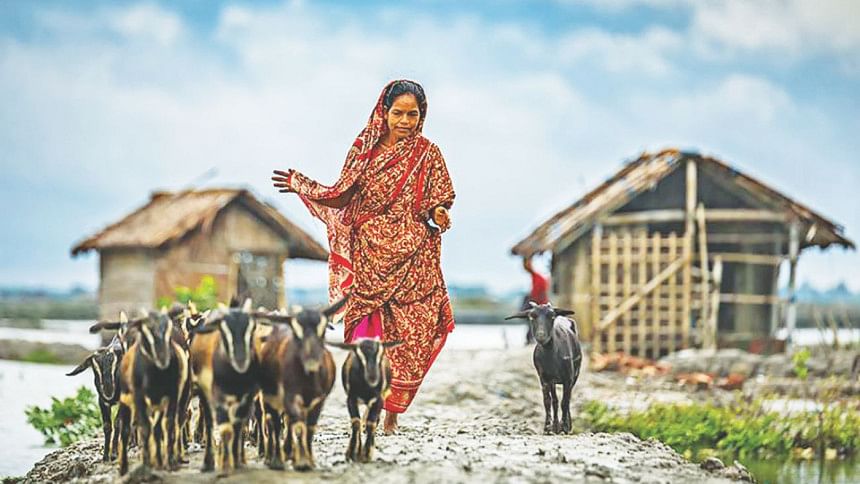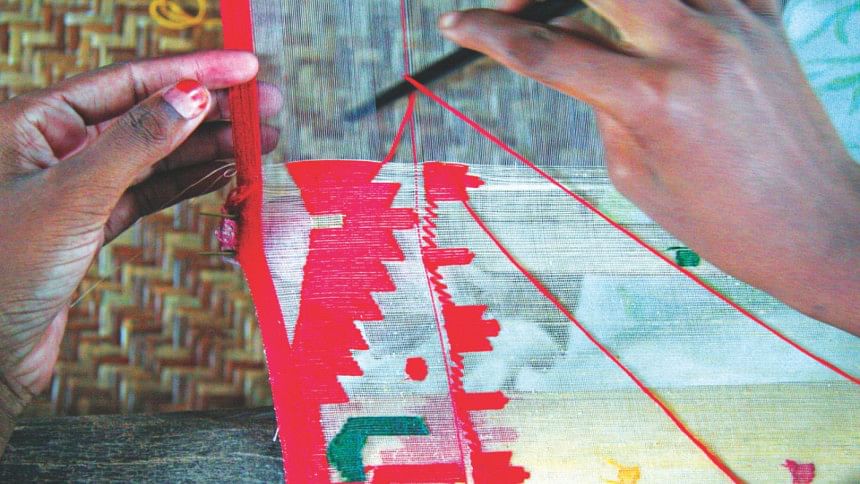After Jamdani and Hilsa…

In the last one year, two Bangladeshi products—Jamdani and Hilsa—received Geographical Indications (GI) from the Department of Patents, Designs and Trademarks (DPDT). In addition, the DPDT is currently working on analysing 24 more goods, which might soon join the list.
But what does this recognition stand for and what are its benefits? There seems to be no end to misconceptions regarding the issue.
DPDT registrar, Md Sanowar Hossain admits that one of the most crucial aspects about Intellectual Property in Bangladesh is that it is widely misunderstood in the country, since its still a comparitively new concept.
A GI is basically a sign used on products, which corresponds to a specific geographical location or origin. The product, because of the GI, eventually gets a brand value and that helps in trade. In Bangladesh, as per the GI law that came into effect in 2015, the DPDT is responsible for registering goods under the GI.
Earlier this month, Hilsa,the country's leading fish delicacy became a GI product. Soon after a section of media organisations responded to this news with headlines such as 'Ilish now belongs to Bangladesh' or 'Bangladesh patents Hilsa.'
There is a sentiment amongst the general public that the GI is a certification that the country has received from an international organisation and that no other country, apart from Bangladesh, can receive a GI certification for Hilsa. As Hossain explains, this is not true.
For starters, GI certifications are given to agricultural products like mangoes, natural products like Hilsa or even handicrafts like Jamdani. For a product to receive a GI certification, it has to be produced or be present in a specific area and it has to be solely dependent on the elements—such as a particular kind of soil or climatic condition—of that area.
Take for instance the case of mangoes from Rajshahi. It is said that the mangoes of Rajshahi are sweeter than the ones cultivated outside the division because of the particular kind of soil that the tree grows on. Similarly, it is said that the climatic conditions in Bangladesh have helped in the cultivation of Hilsa.
As such, Hilsa has received the GI certification and there is a good chance that mangoes from Rajshahi might also receive a similar certification in the future.
What this also means is that countries like India or Myanmar, which produce around 20 percent of the world's Hilsa as opposed to Bangladesh's 70, can also provide Hilsa, grown in their region, with a GI, since they too have been producing it. Sure enough, there will be a difference in the quality of the Hilsa produced there and the ones produced locally, but the provision of the GI depends upon the respective government of the country and not any international organisation.
"I think there is a lot of misunderstanding regarding this issue and that can be counterproductive. Ilish is produced in 11 countries and every country can have its own GI based on their respective law. In the international market though, only the product that maintains its quality will survive. Earlier, there was no branding, but now there will be a logo from the Bangladesh government on each of the boxes containing the Hilsa," explains Hossain.
Iftekhar Iqbal, Associate Professor, History Deparment, Dhaka Univerisity, shares a similar sentiment. "We are sharing the same water space as the other countries and in that case even the other countries can go for a GI. We cannot claim the sole authority. But in the case of Jamdani it was unique. India wanted to have Jamdani, but we proved through various factors that Jamdani belongs solely to us," he says.

The Department of Patents, Designs, and Trademarks (DPDT) under the Ministry of Industry is responsible for providing GIs in Bangladesh. If an association wants to pitch a product or a good for GI certification, it needs to provide a research paper explaining in detail the history of the product.
The DPDT will then examine the report and find out if it meets the required criteria. If it does, the report will be published in the government's gazette journal, after which the DPDT will wait for two months to see if any person or organisation, either from Bangladesh or abroad, provides an objection. If there's no objection filed during the two-month period, that product will eventually receive a GI.
Henceforth, the Association, which applied for the certificate will be given a logo from the DPDT which its members can use in its trade.
"Research suggests that buyers are willing to pay at least 10 to 30 percent more for registered products. So, products that receive the GI or have our logo on it will be expected to be in higher demand. That in turn will help the manufacturers and actually help them grow," explains Hossain.
However, it's up to the association to maintain the quality of the product. If they don't, then the value of the brand will fall, he adds.
It is also the DPDT's duty to inform the World Intellectual Property Organisation (WIPO) regarding the number of GIs and patents that it has dispensed every year. The main job of the WIPO is to harmonise the different intellectual property registrations and also help the member nations by providing them with technical training.
The one aspect that Hossain laments is the lack of awareness among the country's traders regarding the GIs. When they first started working back in September 2015, the DPDT had listed around 100 products from the different districts of the country, which have the potential to be GI-certified.
"We keep going to different districts and telling the traders to approach us as this will be good for their business's branding. The form to apply for a GI is available online and so is information about the fees. It's quite straightforward," says Hossain.

Apart from Jamdani and Hilsa, the DPDT has received GI requests for 24 more products. The production of a number of these 24 goods is actually on the decline and receiving the GI could help change their fortunes.
Wild honey from the Sundarbans, for instance, is on the waitlist. According to reports from the government, the collection of honey has been decreasing in the last few years. Last year, honey collectors gained around 890 quintals of honey, as opposed to the 1000-plus quintals that the traditional honey hunters generally get each year.
Apart from increasing salinity in the Sunderbans due to climate change, the government officials blame the decrease in the collection of honey to the commercial production of honey outside the forests. As such, a certification of the honey from the Sunderbans could actually help the traditional honey hunters who put their lives in danger every time they go to collect honey in the forests.
The Black Bengal Goat, a breed which is found all over Bangladesh might also receive a GI certification if things proceed as per plan. It's a kind of breed that works out well for the poor since it does not require much food but has a high reproduction rate. They can eat almost everything and their high-quality meat and skin is in good demand.
An application to the DPDT has also been filed for the famous Meherpur-based misti Sabitri. According to owners of sweet shops in Meherpur, the sweet was first made there around 140 years ago and ever since then the legacy has continued.
Sylhet's very own Agar, a kind of perfume extracted from Agarwood trees might also receive the GI status. According to the Bangladesh Agar and Ator Manufacturers and Exporters Association, the industry needs help from the government in order to compete with countries like Malaysia and India who are far ahead where exports are concerned. Most of the Agar products are exported to the Middle East.
According to the BAAMEA, the Agar industry employs around 35,000 people with more than 300 companies. One of their major complaints is that they don't have a well-structured export route, because of which many buyers reportedly are compelled to cancel their orders.

While getting a number of products under the GI is crucial, it is more important to ensure that the manufacturers, such as the Jamdani weavers and the honey hunters, actually benefit from these moves.
"Getting Bangladesh to have the GI status is one thing and the benefits for the actual weavers and honey collectors is another. There are some middlemen associations who are representing the primary producers, but there are a few grey areas we need to address. We may need by-laws regarding this issue in the near future. I am sure the policymakers will look into this. To me what's most important is to secure the livelihoods of those poor people, so that they get the benefits," says Dr Iftekhar.
It's barely been a year since Jamdani received its GI status and a little more than a week since Hilsa was incorporated into this list. As such, it will take some more time to analyse the extent of benefit that the weavers have actually received.
There's no doubt that the GI is a brilliant initiative and has the capacity to preserve the uniqueness of the country's culture and that the DPDT should include as many products as it can in the coming years. It's a step that can improve our foreign exchange and help the nation as a whole. However, one also hopes that as time progresses, the primary producers, the people who are actually in need of help—the weavers, the fishermen, the honey hunters—aren't left behind; for there's no point of being proud owners of the Jamdani and the Hilsa, if the very roots are forgotten.

 For all latest news, follow The Daily Star's Google News channel.
For all latest news, follow The Daily Star's Google News channel. 








Comments